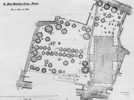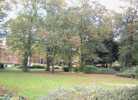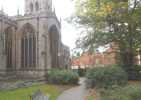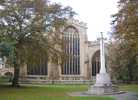 Newark Newark
St Mary Magdalene
Churchyard
The main churchyard appears to have been to the north of the church. The charter
of Henry II, of between 1154 and 1169, mentions the ‘house with
the land on the northeast of the Mother Church of Newark’ and later
charters make it clear that the vicarage lay to the north of the churchyard.
In 1349 Newark suffered greatly from the plague like the rest of the country,
and it was necessary to enclose an extra piece of land in Appletongate. A licence
was granted for the dedication of the churchyard on 5th May 1349. Whether this
is to be identified with the whole of the area between the east end of the
church and Appletongate and bounded now by the Church Walks is not certain.
In 1605, according to the Corporation Records, those who died in the current
outbreak of plague were to be buried ‘near the wall towards Appletongate’.
There were various buildings in or on the edge of the churchyard, at different
times. In 1293 Henry de Newark built a chapel dedicated to St Katherine
and St Martha, which only lasted until 1312 when it was knocked down and
its materials used towards building the south aisle of the church. It is not
clear from the documents where this chapel was located. The discovery of three
skeletons (probably from medieval times) under the area to the south of the
church in 1995, may indicate that there was once a graveyard there, in which
case the chapel may have been near the site of the ‘new’ south
aisle.
By the end of the eighteenth century the churchyard was becoming very overcrowded
and it was decided to take steps towards its enlargement. An Act of Parliament
was obtained in 1773 for the sale of some of the charity estates to enable
the building of the Town Hall and Shambles and for the enlarging of the churchyard.
As a result £200 was given for the purchase of thirty-seven perches of
the glebe belonging to the Vicar and let as gardens, for the enlarging of the
churchyard. This was probably the land to the east of the Vicarage. This area
is recorded as part of the churchyard in W Attenburrow’s map of
1790. By 1818 it was decided that the churchyard required further extension
so the Vicarage was demolished and the land added to the churchyard. In exchange
the house in Appletongate, opposite the east end of the church, was purchased
for a Vicarage. The north churchyard ceased to be used for burials in 1856
because it was again
‘full to capacity’ and the Borough cemetery was opened on London
Road.
In 1905 the north churchyard was laid out for public use.
The east churchyard found a new rô1e in the twentieth century: in 1919
it was chosen as the site for the town’s memorial to
those who died in the Great War.
In 1950 the north churchyard was transformed into a Garden of Rest, opened
by Dr CF Garbett, Archbishop of York, on 26th June.
 Plan
of the churchyard Plan
of the churchyard
in 1896 |
 The
north churchyard The
north churchyard
as it now is,
looking north-west |
 Part
of the north churchyard Part
of the north churchyard
and north transept |
 The
east churchyard with The
east churchyard with
the War Memorial,
showing the east face
of the church |
| 


 Plan
of the churchyard
Plan
of the churchyard The
north churchyard
The
north churchyard Part
of the north churchyard
Part
of the north churchyard The
east churchyard with
The
east churchyard with





